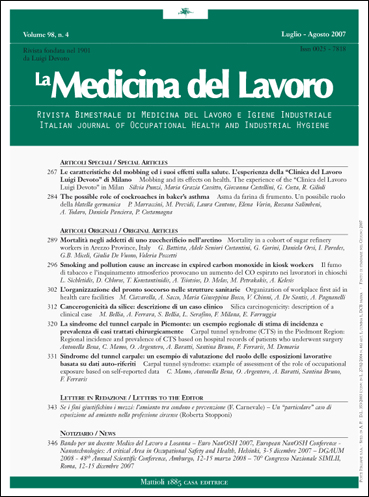Mortalità negli addetti di uno zuccherificio nell’aretino / Mortality in a cohort of sugar refinery workers in Arezzo Province, Italy
Contenuto principale dell'articolo
Keywords
Sugar refinery workers, asbestos occupational exposure, mortality study
Abstract
Questo studio descrive la mortalità di una coorte di 1.767 lavoratori uomini di uno zuccherificio in provincia di Arezzo, dove l’amianto è stato utilizzato dagli anni ‘60 per l’isolamento di sistemi termo-idraulici. Negli anni 1987-88 gli addetti hanno rimosso le coibentazioni in cemento-amianto presenti nello stabilimento. Il periodo di follow-up va dal 01/03/1962 fino al 31/05/2003. La mortalità osservata è stata confrontata con quella attesa in base ai tassi di riferimento della regione Toscana. I rischi relativi sono stati stimati utilizzando il rapporto standardizzato di mortalità (SMR) e gli intervalli di confidenza sono stati calcolati al 95% (IC95%). La maggior parte dei lavoratori sono stagionali (agosto-ottobre). Si osserva una significativa diminuzione della mortalità sia generale (SMR=78; IC95%=696-88), per tutti i tumori (SMR=80; IC95%=659-97), per le malattie cardiovascolari (SMR=64; IC95%=50-81) per il tumore del polmone (SMR=66; IC95%=43-98) e per le malattie dell’apparato digerente (SMR=53; IC95%=26-98). Eccessi di mortalità non significativi sono stati registrati per tumore del rene (SMR=229; IC95%=92-472) e malattie del sistema nervoso (SMR=155; IC95%=71-294). La mortalità per tumore del rene in operai impiegati per almeno 5 anni è risultata significativamente elevata (SMR=508; IC95%=105-1485). In conclusione, la mortalità per patologie amianto-correlate negli operai dello zuccherificio non è aumentata rispetto a quella della popolazione toscana. La mortalità più elevata per tumore del rene negli addetti impiegati per 5 o più anni potrebbe dipendere da varie esposizioni a sostanze cancerogene occorse non esclusivamente nell’ambito del lavoro svolto allo zuccherificio, dato che gli operai erano per la maggior parte stagionali, e svolgevano altri lavori durante l’anno. Rimane da verificare nei prossimi anni la possibilità che si registrino decessi per patologie amianto-correlate, dovuti all’esposizione occorsa alla fine degli anni ’80 durante le scoibentazioni di manufatti in cemento-amianto.
Mortality in a cohort of sugar refinery workers in Arezzo Province, Italy
Background and Objectives: The aim of this study was to investigate mortality of a cohort of 1,767 male workers employed in a sugar refinery plant located in the Province of Arezzo, Italy, where asbestos had been used from the 1960’s for the insulation of thermohydraulic systems and for furnaces. In 1987-88 workers removed the asbestos-cement insulation from the plant. Methods: The cohort was composed by male workers who were employed in the plant between 1 March 1962 and 1 February 1996, and had worked for at least 2 months. Follow-up started on 1 March 1962, and ended on 31 May, 2003. The population mortality for Tuscany Region was used as the reference. The relative risk was estimated by Standardized Mortality Ratio (SMR) and the confidence intervals were calculated at a 95% level (95%CI). Results: The majority of workers were employed during the summer only. Significant decreases in mortality were observed for overall mortality (SMR=78; 95%CI=69-88), all cancers (SMR=80; 95% CI=65-97), cardiovascular diseases (SMR=64; 95%CI=50-81), lung cancer (SMR=66; 95%CI=43-98), and gastrointestinal diseases (SMR=53; 95%CI=26-98). Non-significant increases were observed for kidney cancer (SMR=229; 95%CI=92-472), and diseases of the nervous system (SMR=155; 95%CI=71-294). Kidney cancer mortality for workers employed for >=5 years was significantly higher (SMR=508; 95%CI=105-1485). Conclusions: Mortality for asbestos-related diseases did not show any increase. The higher kidney cancer mortality for workers employed for >=5 years could be due to exposures to various carcinogens, that occurred not only in the sugar refinery plant, given that the workers were seasonal and did other jobs during the rest of the year. Asbestos-related deaths could occur in the future among some workers who in 1987-88 were employed on the removal of asbestos-cement insulation from the plant.
Mortality in a cohort of sugar refinery workers in Arezzo Province, Italy
Background and Objectives: The aim of this study was to investigate mortality of a cohort of 1,767 male workers employed in a sugar refinery plant located in the Province of Arezzo, Italy, where asbestos had been used from the 1960’s for the insulation of thermohydraulic systems and for furnaces. In 1987-88 workers removed the asbestos-cement insulation from the plant. Methods: The cohort was composed by male workers who were employed in the plant between 1 March 1962 and 1 February 1996, and had worked for at least 2 months. Follow-up started on 1 March 1962, and ended on 31 May, 2003. The population mortality for Tuscany Region was used as the reference. The relative risk was estimated by Standardized Mortality Ratio (SMR) and the confidence intervals were calculated at a 95% level (95%CI). Results: The majority of workers were employed during the summer only. Significant decreases in mortality were observed for overall mortality (SMR=78; 95%CI=69-88), all cancers (SMR=80; 95% CI=65-97), cardiovascular diseases (SMR=64; 95%CI=50-81), lung cancer (SMR=66; 95%CI=43-98), and gastrointestinal diseases (SMR=53; 95%CI=26-98). Non-significant increases were observed for kidney cancer (SMR=229; 95%CI=92-472), and diseases of the nervous system (SMR=155; 95%CI=71-294). Kidney cancer mortality for workers employed for >=5 years was significantly higher (SMR=508; 95%CI=105-1485). Conclusions: Mortality for asbestos-related diseases did not show any increase. The higher kidney cancer mortality for workers employed for >=5 years could be due to exposures to various carcinogens, that occurred not only in the sugar refinery plant, given that the workers were seasonal and did other jobs during the rest of the year. Asbestos-related deaths could occur in the future among some workers who in 1987-88 were employed on the removal of asbestos-cement insulation from the plant.






